|
Posted: 8/6/2018 8:45:08 PM EDT
I am in the midst of lots of research. Looking for an optic for my 7.62 REPR in a 16'' barrel. I'm told that rifle is accurate to 600 yards. So I think a variable optic to 6x (or maybe 8x) would be a good choice.
I thought I wanted a first focal plane (to make the reticle consistent over any power). However, in my research it seems like a lot of the 1-6x (or lower) are second focal plane. Why is that? How hard is it to adjust my aim/holdover if I'm shooting steel at 100 yards at 1x and then adjusting to 300 yards at say 4x? My only experience is shooting at 100 yards...I do not hunt big game. I will use this rifle for target practice and hunting coyotes around our lodge land. Second Focal Plane: Vortex Razor HD II 1-6x24 Kahles K16i 1-6x24 Steiner P4Xi 1-4x24 Swarovski X6i 1-6x24 First Focal Plane: Trijicon Vcog 1-6x24 Trijicon Accupower 1-8x28 Primary Arms Platinum 1-8x24 Nightforce NX8 1-8x24 Leupold Mark VI 1-6x20 Seems like it is more common for the 1-8 to be FFP. Why is this the case? I'm trying to understand this so I can narrow down my choices. TYIA, |
|
|
|
Quoted:
Cuz you can't see the reticle from 1-3X. View Quote A reticle on an FFP LPVO should be specifically designed to be used on an FFP LPVO. Usually, that means having a segmented circle or a large circle around the reticle. At 1x, you use it like an Eotech or red dot. The Eotech Vudu 1-6x is a good example. The SWFA 1-6 is also a similar design |
|
|
|
|
|
In a 1-6 FFP isn’t really necessary, but it does make the optic more complex, heavy, and costly. If you are using it at 1X you don’t need whatever ranging features the reticle has, and if you need to use those ranging features you should probably be at 6X. In either case, you don’t need FFP.
|
|
|
|
Quoted:
In a 1-6 FFP isn’t really necessary, but it does make the optic more complex, heavy, and costly. If you are using it at 1X you don’t need whatever ranging features the reticle has, and if you need to use those ranging features you should probably be at 6X. In either case, you don’t need FFP. View Quote A properly designed FFP reticle is awesome at 1x and awesome at 6/8x (or 5x/7x, if you make a fumble) |
|
|
|
|
|
Quoted:
That's only for poorly designed reticles. A reticle on an FFP LPVO should be specifically designed to be used on an FFP LPVO. Usually, that means having a segmented circle or a large circle around the reticle. At 1x, you use it like an Eotech or red dot. The Eotech Vudu 1-6x is a good example. The SWFA 1-6 is also a similar design View Quote View All Quotes View All Quotes Quoted:
Quoted:
Cuz you can't see the reticle from 1-3X. A reticle on an FFP LPVO should be specifically designed to be used on an FFP LPVO. Usually, that means having a segmented circle or a large circle around the reticle. At 1x, you use it like an Eotech or red dot. The Eotech Vudu 1-6x is a good example. The SWFA 1-6 is also a similar design |
|
|
|
Quoted:
In a 1-6 FFP isn’t really necessary, but it does make the optic more complex, heavy, and costly. If you are using it at 1X you don’t need whatever ranging features the reticle has, and if you need to use those ranging features you should probably be at 6X. In either case, you don’t need FFP. View Quote You're just moving the reticle from the rear of the erector assembly to the front. This does require greater precision and QC which increases cost. |
|
|
|
Quoted:
That's only for poorly designed reticles. A reticle on an FFP LPVO should be specifically designed to be used on an FFP LPVO. Usually, that means having a segmented circle or a large circle around the reticle. At 1x, you use it like an Eotech or red dot. The Eotech Vudu 1-6x is a good example. The SWFA 1-6 is also a similar design View Quote |
|
|
|
Quoted:
The mechanism is not more complex and the scopes are not heavier. You're just moving the reticle from the rear of the erector assembly to the front. This does require greater precision and QC which increases cost. View Quote View All Quotes View All Quotes Quoted:
Quoted:
In a 1-6 FFP isn’t really necessary, but it does make the optic more complex, heavy, and costly. If you are using it at 1X you don’t need whatever ranging features the reticle has, and if you need to use those ranging features you should probably be at 6X. In either case, you don’t need FFP. You're just moving the reticle from the rear of the erector assembly to the front. This does require greater precision and QC which increases cost. |
|
|
|
Quoted:
doty_soty is absolutely correct here. View Quote If there was an optic with a relatively wide magnification range (1-8x, 2-12x, or similar) with a daylight-bright illuminated Center Dot (think Firedot) and/or Horseshoe in the Second Focal Plane, with a MIL or MOA or even ACSS reticle in the First Focal Plane, it could be the ideal do-everything type of optic. Would the difficulty & cost to do it right just be too much? |
|
|
|
Quoted:
perhaps your right, but most FFP scopes require illumination at below 3x View Quote View All Quotes View All Quotes Quoted:
Quoted:
That's only for poorly designed reticles. A reticle on an FFP LPVO should be specifically designed to be used on an FFP LPVO. Usually, that means having a segmented circle or a large circle around the reticle. At 1x, you use it like an Eotech or red dot. The Eotech Vudu 1-6x is a good example. The SWFA 1-6 is also a similar design The illumination is what made 'em useable, but they bloom worse than an Aimpoint for my eyes and are just not worth a shit for me at close range. |
|
|
|
Thanks guys, great discussion and I'm (the op) following along.
I've seen it reiterated that FFP is good at any magnification, for example, if you make a mistake and end up on 5x or 7x. Likewise, it's been stated that the assumption for SFP scopes is that they'll either be shot at 1x or at full magnification (6x or 8x). So does a SFP perform better at full magnification (6x or 8x) as opposed to something in the middle (say 3x)? If so, why? If I can easily shoot at 1x at 100 yards, and now say I want to shoot 4 or 5x at 300 yards, how hard is that? Or do people just crank it to full magnification (5x or 8x) for 300 yards and for some reason this is easier? I'm sorry for newb questions. Understanding is key to my purchasing process. I've never shot a rifle over 100 yards, and I've done that only with iron sights, a 1x Vortex sparc, and a 3x Vortex magnifier. Hence, I need to learn. Thanks! |
|
|
|
Quoted: Mike, since we're on the topic of FFP vs SFP, what are your thoughts on a dual focal plane scope? If there was an optic with a relatively wide magnification range (1-8x, 2-12x, or similar) with a daylight-bright illuminated Center Dot (think Firedot) and/or Horseshoe in the Second Focal Plane, with a MIL or MOA or even ACSS reticle in the First Focal Plane, it could be the ideal do-everything type of optic. Would the difficulty & cost to do it right just be too much? View Quote They were all north of 2400ish and required quite a bit of hand fitting. |
|
|
|
I will be addressing some of the statements and questions on this thread.
In Part #1 I will discuss the FFP vs RFP reticle. In Part #2 I will give some history behind the development of the first 1-6 FFP LPVO Part #1 I think there is a lot of misinformation put out regarding a FFP reticle scope vs a RFP reticle scope. I think much of the incorrect information comes from a lack of hands on experience. A: Size -weight-price---When I set out to have the first 1-6x24 FFP reticle scope made I was told by the people who made the scope for me there would be very little difference in price between a FFP or RFP reticle scope. Also size and weight were not a factor between FFP or RFP reticle scope. The first 1-6x24 was actually about the same size and weight of many of the 1-4 scopes at the time. B:Many have said that you will only use the LPVO at the lowest or highest magnification. This has not been my experience. I think it is important to understand that when I set out to have the first 1-6 scope made there were already 1.5-6 scopes in existence. The primary reason for 1x was---- DYNAMIC SPEED---at CQB distances while engaging multiple targets. At 1x a FFP or SFP reticle scope with a #1 WELL DESIGNED RETICLE, #2 GENEROUS EYE RELIEF and a #3 LARGE EYE BOX will perform similar to a RDS when the situation is up close and personal. At 1x --- #1,#2 and#3 allows the reticle (aiming point) to flow from target without inducing vertigo. #1,#2,#3 are all extremely important in this application. All scopes are not equal in this regard. Hands on live fire is the best way to evaluate this area of performance. Using Intermediate magnification settings 2x, 3x etc: For situations other than CQB I like to have the magnification set right about 1.75-2x. The scope is still very fast with a wide FOV and a little magnification helps with snap shots to about 200 yds. In my experience 200 yds is about the max effective range for a snap shot. Past 200 yards I have to slow down and use support to reliably hit a head or chest sized target. Anyone who has ever used optics in low light environments knows that you can see thru a scope better at the lower magnification level. FOV is always important. Lower x= more FOV. C: Reticle Design-----THIS IS THE DEAL BRAKER----- especially for the FFP reticle scope. As many have said, if you do not have a well designed reticle in a FFP or RFP LPVO the scope will not work well at 1x. This is even more critical for the FFP reticle scope and this is where many of the LPVOs fall short, BUT a LPVO with a well designed reticle will kick ass, FFP or SFP. Which has the advantage? IMO a WELL DESIGNED reticle in a FFP scope will have huge advantage, especially in real combat. At 1x your CQB aiming point should be big enough to be fast but small enough to be accurate. Remember the three most important factors in stopping power are SHOT PLACEMENT--SHOT PLACEMENT and SHOT PLACEMENT. Why does a WELL DESIGNED FFP reticle LPVO have a advantage over the SFP reticle LPVO? Same reticle in a FFP vs RFP LPVO. IMO---If ---the reticle design incorporates ranging capabilities then the FFP reticle LPVO would be my choice for a true tactical scope. Past 200 yds for head shots and past 300 yards for chest shots accurate ranging is critical. D: Illumination; day light bright is desirable but the reticle design should work with no illumination at all. Part#2 Here is some information you may find interesting about the development and capabilities of the 1-6x24 scope. When I first introduced the concept of the FSCO (Full Spectrum Combat Optic) 1-6x24 FFP Horseshoe reticle scope for use on a modern assault rifle or battle carbine the concept was met with a lot of resistance. Why do we need a 1-6? FFP reticle----NO WAY. Horseshoe reticle-----THAT THING IS STUPID---WAY TO BIG!!!!!! Interesting. Look what the Army just purchased, SIG Tango 6 Please let me clarify that the Horseshoe reticle in the scope I developed and the the Horseshoe reticle in the Sig scope are similar but I don't think the Sig scope uses the "RULE Of Ten" in their reticle. Our scope is made and assembled in Japan. In the past several years we have done a lot of testing developing of our Combat Rifle Scope (CRS). This thread is about a optic for a fighting rifle, my comments will be based on that. Before I go any further let me define some of the terms I will be using. Full spectrum: From CQB distance to max effective range. Day or night. Maximum effective range (hits on target): The maximum range at which the average shooter will hit the target (human) more than he misses it. Point target engagement: a specific size target that you can expect to hit to a specific distance. Example, a human head would be a point target to about 300 yards. A human chest would be a point target to about 600 yards. Area target engagement: A specific size target at a specific distance that you do not expect to hit but hope to hit. Example: A human head would be a area target for a assault/battle rifle or battle carbine at 1,000 yards. Package: your rifle--scope and ammo. Intrinsic accuracy: The maximum degree of accuracy that a package can deliver when not affected by outside factors such as wind or human error (movement) etc. Practical accuracy: The degree of accuracy obtainable when used in the real world taking into account factors such as wind and human error etc. Anatomical reticle: The reticle in the CRS is based on the size of the average adult human body (male). In the military I was taught: Head: ~ 8 to 10" Shoulder width: ~ 18 to 20" Shoulder to mid sternum: ~10'' Width of a man front to back (sideways) mid sternum: ~ 10 to 12" I call this the "RULE OF 10". The scale on the CRS reticle is based on 10''. The primary ranging system of the CRS reticle is based on the head. Secondary ranging system is based on shoulders and you can also range on a man using his body width. In the military I was taught to lead a moving target or adjust for wind by estimating aiming leadings in body widths. The Horseshoe is designed to allow you to do this out to 300 yards. Starting at 400 yards the CRS reticle has a series of horizontal gaps and dashes. These are in 10'' increments (BODY WIDTH) at the given distance. This allows you to adjust your aiming point for wind or moving targets. On the 5.56 reticle there is a MIL DOT scale on a horizontal plane at the 3 and 9 o'clock position of the Horseshoe. This can be used for milling a target or to determine cant. On the .308 reticle there is also a MIL DOT scale on a vertical plane. It is very easy to learn how to use this reticle and more important, REMEMBER how to use it when the bullets are flying and people are dying. OK----So hear we go. From the beginning the objective was to develop a rugged optic that would help keep our war fighters alive in combat. The concept called for a Full Spectrum Combat Optic (FSCO) for the modern assault/battle rifle and battle carbine. I named this the CRS. I was taught in the military that the max effective range for the M14 or M16 was about 600 yards. I was also taught when using a magnified optic you should have 1X for every 100 yards distance to your target. Based on that and about 20 years of T&E I decided that the CRS should be a 1-6 scope with a illuminated FFP reticle. Also the scope should have simple, fast, intuitive anatomical reticle that would allow the scope to fulfill the FSCO role. In my opinion the scope should have capped turrets and all aiming adjustments and ranging of the target would be done on the reticle. Several years ago we teamed up with a top scope manufacture from Japan and got it done. Initially the reticle (M4-62reticle) was calibrated to the M855 5.56 ammo fired from a 14.5" barreled (M4 type) rifle with a 1 in 7" twist. The M4-62 reticle is calibrated to 800 yards. After we got that done we did a new reticle (175-16 reticle) calibrated for the M 118 LR ammo fired from a 16" barreled .308 rifle (battle carbine)t with a 1 in 10" twist . The 175-16 reticle is calibrated to 1,200 yards. Now here is what we have found after a lot of testing with these scopes. The max effective range with our current infantry rifles and ammo is farther than 600 yards. It is important to remember that the package is zeroed at 100 yards and all aiming corrections are made on the reticle. We DO NOT touch the W/E turrets. We have tested the 5.56 rifles with 14.5" and 16" 1 in 7" twist barrels using 55 gr, 62 gr and 77 gr ammo to 1,000 yards on human sized targets. We have found max effective range for point target engagement on a human size targets is about 800 yds with the 5.56 ammo. Best accuracy results are achieved with the 77 gr ammo. The 55 and 62 gr is iffy at this distance but it has been done. The BIG problem Is the wind at that distance. There is a poa/poi difference in elevation when using different weight ammo but it is easy to correct for using the reticle. Based on the intrinsic accuracy and field testing of this package I believe max effective range will be about 800 yards when using the 77gr ammo. . We have been able to get hits on target to 1,000 yards (area target engagement ) when using the 5.56 ammo with the 175-16 (.308) reticle. The ballistic path of the 77gr. ammo out of a 16" 1 in7" twist barrel is very close to the ballistic path of the M118LR ammo out of a .308 rifle with a 16" barrel to 1,000 yards. With the .308 package we are getting consistent max effective range on point (20"x35") target engagement to 1,000 yards and area target engagement to 1,200 yards. Again based on our testing and the intrinsic accuracy of this package I believe max effective range is about 1,000 yards. We have tested this package with higher magnification scopes and did not see a improvement in practical accuracy until we got to 10X and beyond and that was a very slight improvement, but our testing has been limited in this regard. At this point I am of the opinion that the 1-6 and the 1-8 scopes we have tested deliver the same degree of practical accuracy at max effective range with this package. Please don't get me wrong, myself and the other testers did like the extra 2X offered by the 1-8 scopes. This would be beneficial for target ID etc. but the extra 2X did not seem to translate to more hits on target or better shot placement. More testing may change my opinion. Up to this point I have been talking about max effective range (long range) performance. The #1 priority for the CRS was CQB performance. Up close you will be faster than your enemy or you will be dead. I believe we can all agree the fastest/best optics for CQB engagements are the red dot gun sights (RDS) like the Aimpoint or Eotech. I think a properly designed LPV can equal or even beat a (RDS) in the CQB environment..Three gun shooters using LPVs in competition bear witness to this. The learning curve for the LPV will probably be a little longer . We have found that eye relief, eye box reticle illumination (indoors) and "fitting" the rifle to the shooter is critical for speed in the CQB environment. In our testing we find the LPVs start to dominate the RDS beyond 100 yards. We have found that ILLUMINATION and RETICLE design are the most important factors in the performance of FSCO. Question; if you are carrying a GP (general purpose) rifle in a combat environment that has max effective range of 800 to 1,000 yards why would you want to put a optic on that rifle that would limit your max effective range to 500 yards or less? Especially when you could put a LPV on that rifle that gives up little or nothing compared to a RDS in the CQB role. Yes I know about OUNCES EQAULS POUNDS AND POUNDS EQUALS PAIN, been there done that, but I also know about carrying a piece of equipment that won't get the job done. We have tested our CRS side by side against other scopes that had better glass better illumination and more magnification. The reticle in the CRS is what would give the CRS the edge. Example: we are shooting out to 1,000 yards. CRS vs Burris 1-8 with a FFP BDC reticle calibrated for 5.56 out to 600 yards. The Burris scope was on a 17" F&D .308 rifle. The CRS was on a 16" LWRC REPR. AMMO-- M118 LR. Burris set at 8x, CRS set at 6x. From 100 to 600 yards the performance of the scopes was the same. With the Burris scope we stopped at 600 yards because to shoot beyond 600 yards with the reticle in the Burris we would have to KNOW our DOPE for that package and use the turrets to dial in the the aiming corrections for the different distances. NOT very practical in a dynamic firefight. WE don't KNOW the DOPE for that package or the REPR package. With the reticle in the CRS we don't need to KNOW the dope, we just need to KNOW the distance to the target and make the aiming corrections on the reticle. The CRS reticle allows you to range a human target very quickly. With the CRS we were able to hit every target to 1,000 yards just using the reticle. We got similar results using the Bushnell 1-8, VCOG and Kahles 1-6. Illumination: The CRS has the whole BDC reticle illuminated and is adjustable for brightness. This allows you to use the BDC reticle indoors and to the maximum range to which it is calibrated in a low light environment. It also works very well with clip on NVDs. Other scopes that only illuminate the top portion of the reticle will require you to use your turrets to engage targets at longer distances in a low light environment. Some have criticized the scope because the illumination is not day time bright. This is a valid criticism, but we have never found the illumination lacking in a indoors environment and don't find it necessary outdoors on a bright day. The size and thickness of the Horseshoe portion of the reticle was designed to be used at low power for fast hits on target (Combat Accuracy) from CQB distances to 300 yards in day light without illumination. I think the following videos will illustrate this point. What will happen to a scope that depends on its illuminated reticle to be fast on target if the illumination fails? https://www.youtube.com/watch?v=KrhooRYDUn0&feature=youtu.be https://www.youtube.com/watch?v=aSzcsrXIMyU Here are some pictures of what you can do with the CRS at various distances. Here's Pepper at 1,000 yards. 12 shots.. 5 hits! Pepper claims that is two hits on the right shoulder. So that would 6 hits. Notice Pepper's hair (wind). 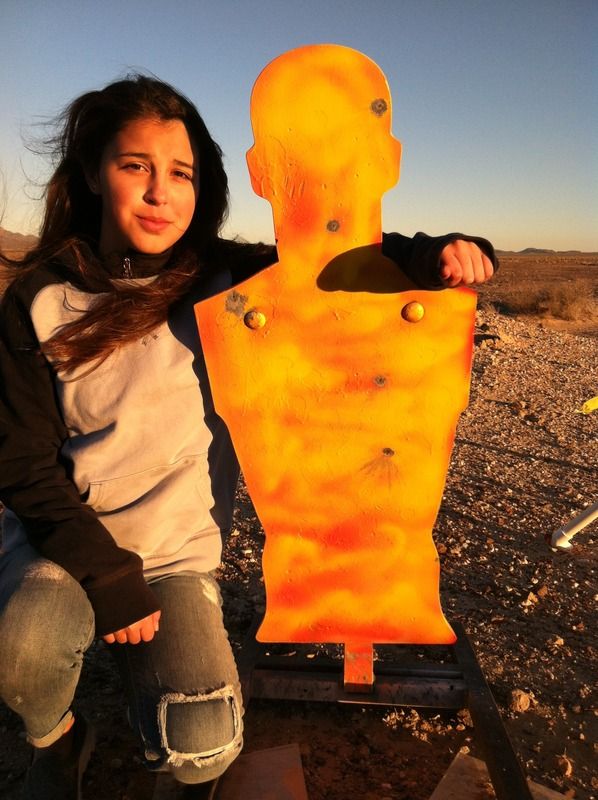
Here's Pepper at 1,025 yards. https://www.youtube.com/watch?v=pnWA-Vt8CS4 Here's the CRS out to 535 yards day and night, using PVS 22. https://www.youtube.com/watch?v=F5Sr6ardD2I Here's some groups we shot at 100 yards. 
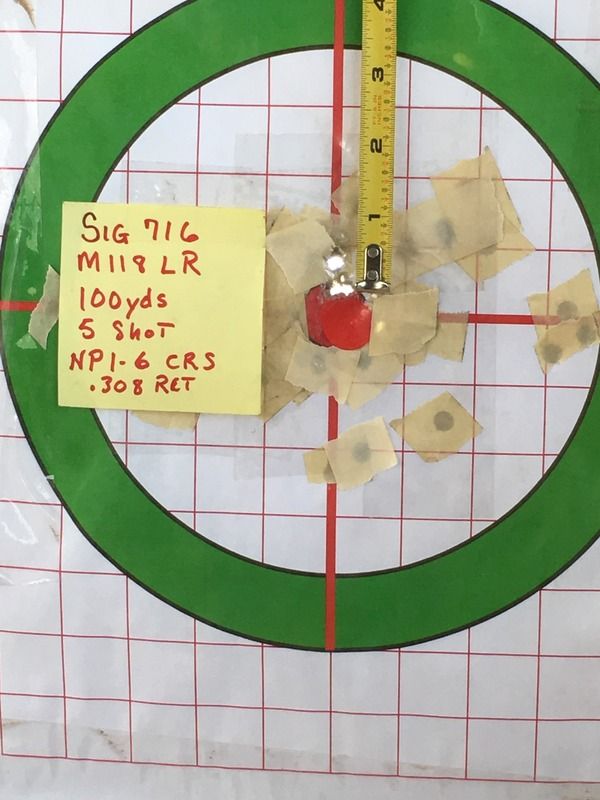
10 shots 7 hits at 1,025 yards. 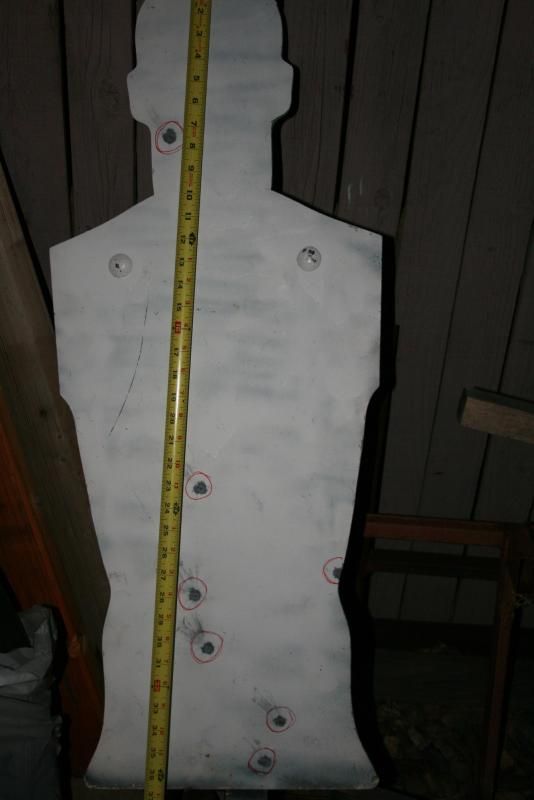
Area target engagement on a 10 inch plate at 1,025 yards. 30 shots 5 hits. 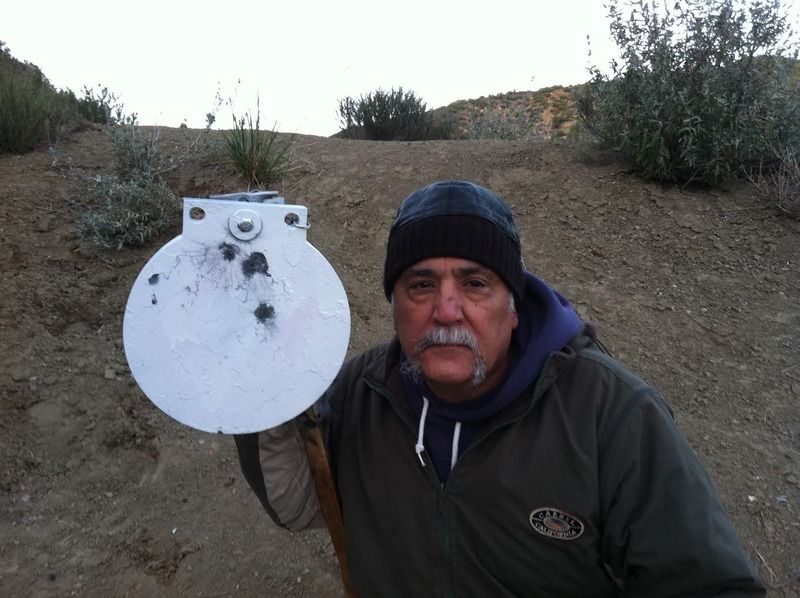
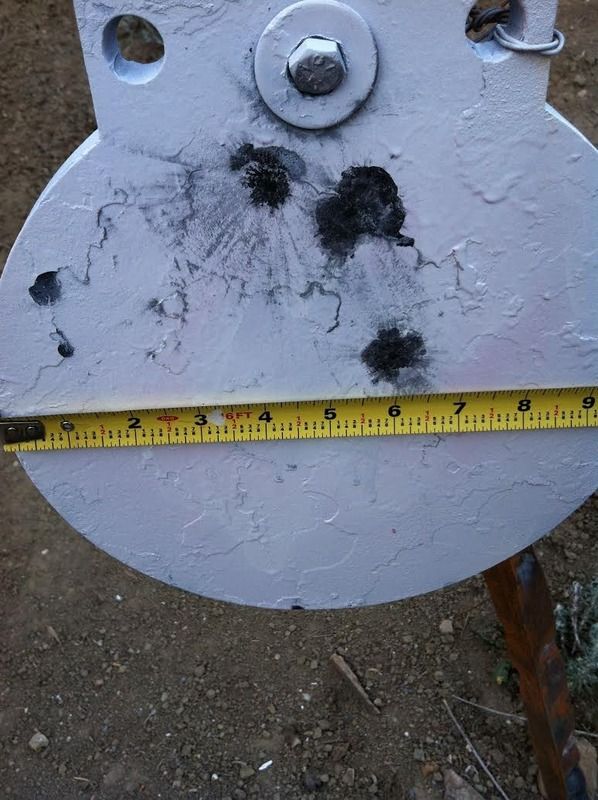
CRS at night using PVS 22 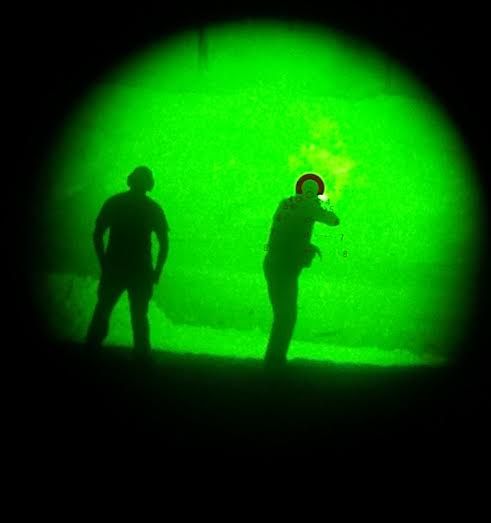
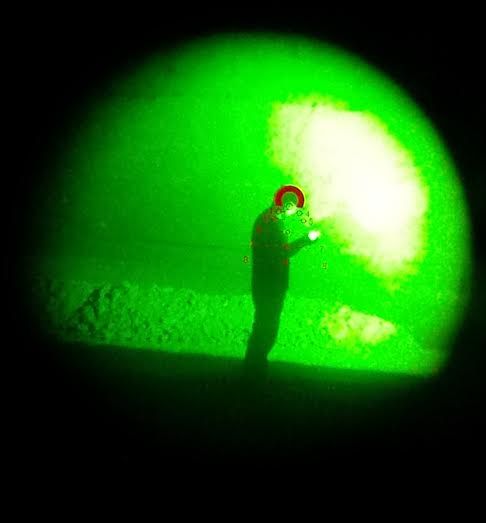
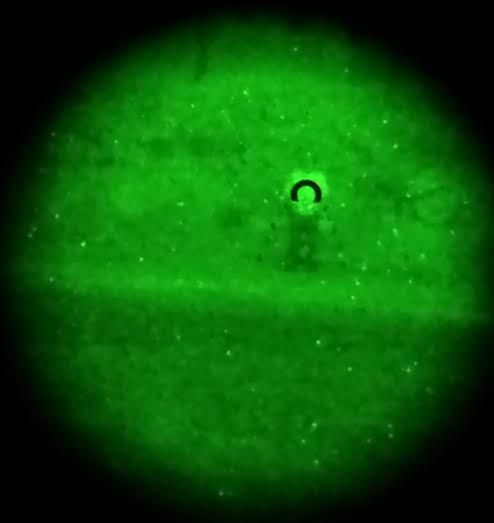
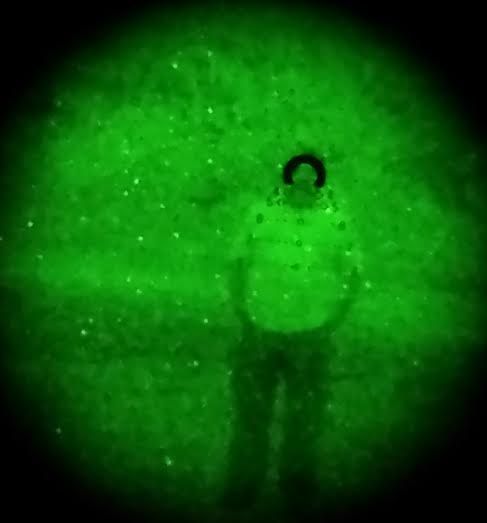
 We have also been testing a prototype of a new 1-10x30 scope. I was able to do a side by side test at 1025 yards with our 1-6 CRS and a prototype of a 1-10x30 we are testing. CRS was set at 6x the prototype was set at 10x. Rifles used were .308 with 16'' 1 in 10 twist barrels. Ammo M118 LR. Target 20'' X26''. Fired two five shot groups, one with each rifle. Hit the target 3 out of five shots with each rifle. Hits with the O around the bullet were made with 10x prototype scope. Hits with the X on the bullet strike were made with 6x CRS. Group size for 3 hits at 1025 yard: 1-6 CRS=12'' 1-10 prototype=13''  Next pictures 1025 yards, target 20x24'' and 20x26''. 1-6 CRS 3 out of 5 hits on target. Group size 20'' 1-10 prototype 2 out of 5 hits. Group size 17'' 
 There doesn't seem to be a big difference in practical accuracy at this range with the extra 4X. Here is another example: same day same rifle (REPR) scope, ammo, etc. different target. Target: 12'' disk (sectional) 1025 yards. Take the rifle out of bag. I didn't check zero. Aim dead on with 1025 aiming point on reticle. First shot (cold bore), spotter calls elevation dead on windage approx 3' right. Second shot, same aiming point to confirm. Spotter calls same impact. 3' is 36'' so I compensate on the reticle using the rule of 10''. Here is the 3rd shot. 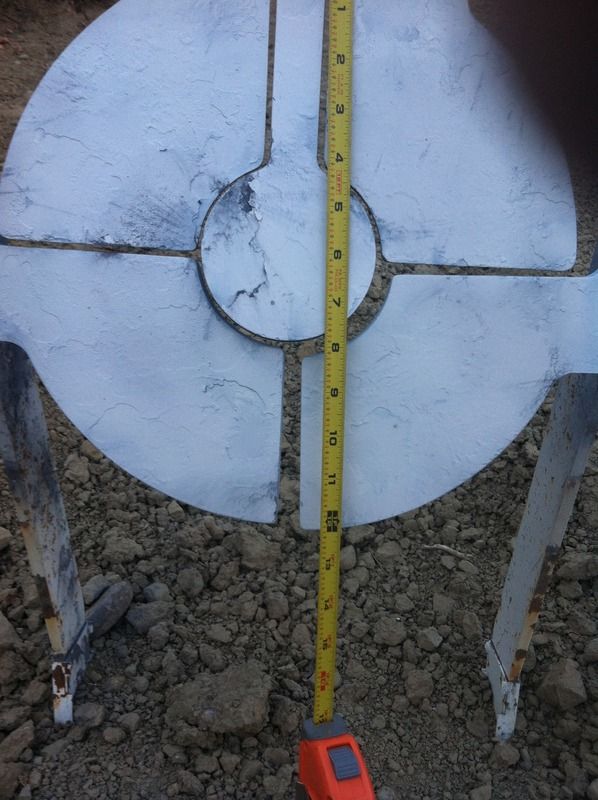
I hope you all found this interesting and it will give a little better understanding of the capabilities of 1-6x24 scope. Ed Verdugo |
|
|
|
Quoted:
I am in the midst of lots of research. Looking for an optic for my 7.62 REPR in a 16'' barrel. I'm told that rifle is accurate to 600 yards. So I think a variable optic to 6x (or maybe 8x) would be a good choice. I thought I wanted a first focal plane (to make the reticle consistent over any power). However, in my research it seems like a lot of the 1-6x (or lower) are second focal plane. Why is that? How hard is it to adjust my aim/holdover if I'm shooting steel at 100 yards at 1x and then adjusting to 300 yards at say 4x? My only experience is shooting at 100 yards...I do not hunt big game. I will use this rifle for target practice and hunting coyotes around our lodge land. Second Focal Plane: Vortex Razor HD II 1-6x24 Kahles K16i 1-6x24 Steiner P4Xi 1-4x24 Swarovski X6i 1-6x24 First Focal Plane: Trijicon Vcog 1-6x24 Trijicon Accupower 1-8x28 Primary Arms Platinum 1-8x24 Nightforce NX8 1-8x24 Leupold Mark VI 1-6x20 Seems like it is more common for the 1-8 to be FFP. Why is this the case? I'm trying to understand this so I can narrow down my choices. TYIA, View Quote A lot of my testing in the development of the .308 reticle for the 1-6 CRS was done with the 16" LWRC REPR. It is my favorite .308 rifle. Ed Verdugo |
|
|
|
If those white steel gongs were painted camo, youd not even see them, much less be making hits like that with 6x. I can shoot great with iron sights on crisp high contrast paper targets of a size that works well with my front sight post width. If its real life and targets are of a subdued color and irregular shape, Id be doing well to get 4 MOA at 100 yards with irons. Id be doing well to SEE a target at 1x at 100 yards that did not want to be seen. A 1-6× long range optic is not viable in reality. It is a close to mid range optic.
|
|
|
|
Quoted:
Thanks guys, great discussion and I'm (the op) following along. I've seen it reiterated that FFP is good at any magnification, for example, if you make a mistake and end up on 5x or 7x. Likewise, it's been stated that the assumption for SFP scopes is that they'll either be shot at 1x or at full magnification (6x or 8x). So does a SFP perform better at full magnification (6x or 8x) as opposed to something in the middle (say 3x)? If so, why? If I can easily shoot at 1x at 100 yards, and now say I want to shoot 4 or 5x at 300 yards, how hard is that? Or do people just crank it to full magnification (5x or 8x) for 300 yards and for some reason this is easier? I'm sorry for newb questions. Understanding is key to my purchasing process. I've never shot a rifle over 100 yards, and I've done that only with iron sights, a 1x Vortex sparc, and a 3x Vortex magnifier. Hence, I need to learn. Thanks! View Quote The difference in price between our 1-6x ACSS scopes in SFP vs. FFP is $110. So, it's not a giant gap in price like it was ten or even five years ago. Don't apologize for this newb question, it's actually SUPER intelligent and shows you are thinking about this correctly and pretty far down the right path. |
|
|
|
Quoted: The assumption for LPVO SFP scopes is that they WILL be used either at 1x or at full mag. They are clearly NOT as useful in between. Practically speaking, most people put a throw lever on them and switch back and forth between those two settings. If they could just flip a switch like on that $1900 ELCAN Specter DR, they would. If you are wanting the flexibility to use, say, 1x power per 100 yards of target distance, which is a practice I personally enjoy (4x at 400 yards, 5x at 500 yards), then spending the extra money on FFP is worthwhile. The difference in price between our 1-6x ACSS scopes in SFP vs. FFP is $110. So, it's not a giant gap in price like it was ten or even five years ago. Don't apologize for this newb question, it's actually SUPER intelligent and shows you are thinking about this correctly and pretty far down the right path. View Quote |
|
|
|
Quoted:
To be fair, 3x is pretty useful with a mil reticle. That said, if you're milling, you're likely beyond 250 yards. I personally like 2-3x or so on a LPV at times. It really helps you out in low light situations where a full 6x will limit light transmission, but you'd reallllyyy like to see that deer/coyote/whatever a hair better. View Quote View All Quotes View All Quotes Quoted:
Quoted: The assumption for LPVO SFP scopes is that they WILL be used either at 1x or at full mag. They are clearly NOT as useful in between. Practically speaking, most people put a throw lever on them and switch back and forth between those two settings. If they could just flip a switch like on that $1900 ELCAN Specter DR, they would. If you are wanting the flexibility to use, say, 1x power per 100 yards of target distance, which is a practice I personally enjoy (4x at 400 yards, 5x at 500 yards), then spending the extra money on FFP is worthwhile. The difference in price between our 1-6x ACSS scopes in SFP vs. FFP is $110. So, it's not a giant gap in price like it was ten or even five years ago. Don't apologize for this newb question, it's actually SUPER intelligent and shows you are thinking about this correctly and pretty far down the right path. |
|
|
|
Quoted: Sure. But the reticle doesn't matter, even a mil reticle will only be useful at max magnification in an SFP presentation. If you have a 1-6x and you try range estimating or turning the mil into a BDC at 3x, you will get it wrong every time. That's the advantage of FFP, you can be at whatever magnification with, say, a simple mil reticle, and if you know your holdovers you can always use them at 3x, 4x, or whatever. View Quote |
|
|
|
Quoted: The assumption for LPVO SFP scopes is that they WILL be used either at 1x or at full mag. They are clearly NOT as useful in between. Practically speaking, most people put a throw lever on them and switch back and forth between those two settings. View Quote |
|
|
|
Quoted: Hondaf 17 A lot of my testing in the development of the .308 reticle for the 1-6 CRS was done with the 16" LWRC REPR. It is my favorite .308 rifle. Ed Verdugo View Quote |
|
|
|
I went to my local gun shop today to check out their selection. They had a Vortex Viper PST, Strike Eagle, Acog, and some random Burris and Leupold. No Trijicon Accupower, Nightforce, or Vortex Razor to take a look at. I was surprised at how dang nice the Strike Eagle was. Felt nice and glass seemed really clear. I'm looking forward to finding a store with more selection. Would like to get hands on the Accupower, Razor, and a Nightforce. Then compare with the PA platinum.
|
|
|
|
|
|
Quoted:
I went to my local gun shop today to check out their selection. They had a Vortex Viper PST, Strike Eagle, Acog, and some random Burris and Leupold. No Trijicon Accupower, Nightforce, or Vortex Razor to take a look at. I was surprised at how dang nice the Strike Eagle was. Felt nice and glass seemed really clear. I'm looking forward to finding a store with more selection. Would like to get hands on the Accupower, Razor, and a Nightforce. Then compare with the PA platinum. View Quote I've noticed pretty much all glass looks clear in stores and buildings. |
|
|
|
Quoted:
Did you go outside and look through them? I've noticed pretty much all glass looks clear in stores and buildings. View Quote |
|
|
|
A second focal plane is not useless at any mag other than 1 or max.
The center dot or whatever part you zeroed with is still the zero. If you're in low enough light to need to dial down to gather more light, several things are going to negate the usefulness of a FFP scope. 1) You can't see the reticle because it's dark and the reticle is tiny. If the illumination is just a cunt hair too bright you can't see anything else. 2) It's dark enough that you can't see far enough to need to use your holdovers. As far as ranging with the optic? Forget it. An LPV doesn't have enough magnification to accurately measure something and I haven't seen one with an appropriate scale in the reticle. Ranging with the reticle is an imprecise exercise that takes enough time that turning the mag ring is not going to be a factor. I've done a lot of UKD shooting and really liked to have a top end of 25X. This is with a big heavy bolt gun. The useful range of a little carbine with a little scope is realistically 3-400 yards. If you zero at 200, and know your holdovers, guess and shoot. You're not going to be shooting 600 yards in a big ass hurry at 3.5X mag and actually hitting anything regardless of the focal plane of the reticle. |
|
|
|
Quoted: Thank you for the very detailed above post, and also for this comment. I have about 200 rounds through the REPR right now, all with iron sights. I'm loving it. Your above post was great, I took the time to read it closely. My thinking is starting to come together. View Quote |
|
|
|
Quoted:
A second focal plane is not useless at any mag other than 1 or max. The center dot or whatever part you zeroed with is still the zero. If you're in low enough light to need to dial down to gather more light, several things are going to negate the usefulness of a FFP scope. 1) You can't see the reticle because it's dark and the reticle is tiny. If the illumination is just a cunt hair too bright you can't see anything else. 2) It's dark enough that you can't see far enough to need to use your holdovers. As far as ranging with the optic? Forget it. An LPV doesn't have enough magnification to accurately measure something and I haven't seen one with an appropriate scale in the reticle. Ranging with the reticle is an imprecise exercise that takes enough time that turning the mag ring is not going to be a factor. I've done a lot of UKD shooting and really liked to have a top end of 25X. This is with a big heavy bolt gun. The useful range of a little carbine with a little scope is realistically 3-400 yards. If you zero at 200, and know your holdovers, guess and shoot. You're not going to be shooting 600 yards in a big ass hurry at 3.5X mag and actually hitting anything regardless of the focal plane of the reticle. View Quote I absolutely LOVE FFP, in it's place, on a high magnification long range rig. On a LPV it's pushing a string. |
|
|
|
Quoted: Samuse, what's your opinion on our ACSS system? Not picking a fight, not a loaded question, just always looking for feedback pro and con. If I don't hear the objections from qualified intelligent shooters then I'm just in an echo chamber full of fanboys and fellow employees all patting ourselves on the back for how awesome we are. So I really am soliciting your honest opinion. Here's our vertical and horizontal ranging setup, Dimitri based it on the old Russian PSO system and developed it further. https://www.primaryarms.com/SSP%20Applications/NetSuite%20Inc.%20-%20SCA%20Mont%20Blanc/Development/img/PA1-8X24SFP-ACSS-5.56_16.jpg?resizeid=7&resizeh=0&resizew=2000 The vertical ranging is easiest to see through the optic and the most accurate. It's calibrated for a 5'10" target, you put the target's feet on the bottom line and wherever the target's head is, that's your range. You can use the ranging bars to make more intelligent estimations, for example if the target's head is in between the 4 and the 5 then he's somewhere around 450 yards. If the target is in tall grass, behind a window, or their full height is otherwise obscured, then you have to go to the horizontal ranging. We correlated horizontal ranging with the BDC for speed, so once you match up the target's width of approximately 18" from shoulder to shoulder, you are already on target for a chest shot. My personal opinion and also rah rah industry shill speak: Our system has a good track record of really working in the real world, assuming you have realistic expectations. Nobody is going to use this system and our BDC to pick off playing cards at 500 yards with a 6x optic. There's a lot of variables involved-- what's the exact loading of your ammo? Are you shooting a 16" M4, a 20" M16, a 10.3" Mk13? What's your altitude above sea level and your barometric pressure? All those factors affect the performance of the BDC even if you get range estimation perfectly right. But you can put full size steel torso targets at unknown ranges out to 600, even 800 yards with the right ammo, and get first or second shot hits SOMEWHERE on those steel targets. View Quote If you tried to switch to 6x and only got to 5x, that's a problem with the training, not the equipment. |
|
|
|
Quoted: Mike, what he's saying is that at 3x power, and 600 yards, you're not going to be able to range a 18" target accurately. If you miss it by 4", you're 22% off. And you just used dope for 400 yards, which means you missed. If you tried to switch to 6x and only got to 5x, that's a problem with the training, not the equipment. View Quote I do agree with the poster above who says he likes 3x mag at 100 yards to 250 yards, where BDC isn't really necessary with 5.56 NATO yet but a little bump in mag can get you a much more confident shot. I totally agree there. Great use of SFP at a mid-range power, you just hardly ever see anyone discuss that. Most folks seem to be either at minimum or maximum, but he's really getting the most out of his optic and thinking things through well. |
|
|
|
Thanks for all the insights, guys. This thread has been hugely helpful to me, and I hope to others as well.
I need to find a Trijicon Accupower 1-8 in store somewhere to check out. I think that's my starting point for now. |
|
|
 Win a FREE Membership!
Win a FREE Membership!
Sign up for the ARFCOM weekly newsletter and be entered to win a free ARFCOM membership. One new winner* is announced every week!
You will receive an email every Friday morning featuring the latest chatter from the hottest topics, breaking news surrounding legislation, as well as exclusive deals only available to ARFCOM email subscribers.
AR15.COM is the world's largest firearm community and is a gathering place for firearm enthusiasts of all types.
From hunters and military members, to competition shooters and general firearm enthusiasts, we welcome anyone who values and respects the way of the firearm.
Subscribe to our monthly Newsletter to receive firearm news, product discounts from your favorite Industry Partners, and more.
Copyright © 1996-2024 AR15.COM LLC. All Rights Reserved.
Any use of this content without express written consent is prohibited.
AR15.Com reserves the right to overwrite or replace any affiliate, commercial, or monetizable links, posted by users, with our own.

